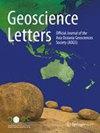A fresh look at the intensity and impulsive strength of geomagnetic storms
IF 4.3
3区 地球科学
Q1 GEOSCIENCES, MULTIDISCIPLINARY
引用次数: 0
Abstract
We notice that the important early decreasing part of the main phase (MP) from the positive main phase onset (MPO) to 0-level of Dst and SymH indices is missed in the treatment of the main phase (MP) of geomagnetic storms. We correct this inconsistency in 848 storms having positive MPO (out of 1164 storms) in SymH during 1981–2019 by raising the 0-level of SymH to the MPO-level. The correction considers the full range of the main phase, increases the corrected (revised) storm intensity (SymHMin*) and impulsive strength (IpsSymH*) by up to − 149 nT and − 134 nT, respectively, and seems important for all aspects of global space weather. For example, the corrected SymHMin* changes the conventional storm identification and classification and corrected IpsSymH* clearly identifies all 3 severe space weather (SvSW) events from over 1100 normal space weather (NSW) events with a separation of 52 nT; it also identifies all 8 minor-system-damage space weather (MSW) events from the NSW events. Large fluctuations occur in the global geomagnetic field during space weather events. The fluctuations at low latitudes are referred as geomagnetic storms. The Dst and SymH indices have been used for studying the storms and other aspects of global space weather. However, we notice that the Dst and SymH values during the main phase and recovery phase of the storms having positive main phase onset (MPO > 0 nT) are significantly less than their actual values. We correct this inconsistency in 848 such storms (out of 1164 storms) in SymH during 1981-2019 by raising the 0-level of SymH to the MPO-level. The corrected/revised storm intensity (SymHMin*) and impulsive strength (IpsSymH*) increase by up to − 149 and − 134 nT. The correction seems important for studying all aspects global space weather. For example, the correction identifies the storms corresponding to severe space weather causing power outage and/or telecommunication failure from those corresponding to normal space weather.重新审视地磁暴的强度和脉冲强度
我们注意到,在处理地磁暴的主相位(MP)时,忽略了从正主相位开始(MPO)到 Dst 和 SymH 指数 0 级的重要的主相位(MP)早期递减部分。我们通过将 SymH 指数的 0 级提高到 MPO 级,纠正了 1981-2019 年期间 SymH 指数中 MPO 为正的 848 个风暴(共 1164 个风暴)的这种不一致。该修正考虑了主相位的全部范围,将修正(修订)后的风暴强度(SymHMin*)和脉冲强度(IpsSymH*)分别提高了-149 nT和-134 nT,似乎对全球空间天气的各个方面都很重要。例如,校正后的 SymHMin* 改变了传统的风暴识别和分类方法,校正后的 IpsSymH* 可以从 1100 多个正常空间天气(NSW)事件中清晰地识别出全部 3 个严重空间天气(SvSW)事件,两者相差 52 nT;它还可以从 NSW 事件中识别出全部 8 个轻微系统损害空间天气(MSW)事件。在空间天气事件期间,全球地磁场会出现大幅波动。低纬度地区的波动被称为地磁暴。Dst 和 SymH 指数被用于研究风暴和全球空间天气的其他方面。然而,我们注意到,在正主阶段开始(MPO > 0 nT)的风暴中,主阶段和恢复阶段的 Dst 和 SymH 值明显小于其实际值。我们通过将 SymH 的 0 级提高到 MPO 级,纠正了 1981-2019 年期间 SymH 中 848 个此类风暴(共 1164 个风暴)的这种不一致性。修正/修订后的风暴强度(SymHMin*)和冲击强度(IpsSymH*)分别增加了-149 nT和-134 nT。校正似乎对研究全球空间天气的各个方面都很重要。例如,修正后的风暴可将导致停电和/或电信故障的严重空间天气与正常空间天气区分开来。
本文章由计算机程序翻译,如有差异,请以英文原文为准。
求助全文
约1分钟内获得全文
求助全文
来源期刊

Geoscience Letters
Earth and Planetary Sciences-General Earth and Planetary Sciences
CiteScore
4.90
自引率
2.50%
发文量
42
审稿时长
25 weeks
期刊介绍:
Geoscience Letters is the official journal of the Asia Oceania Geosciences Society, and a fully open access journal published under the SpringerOpen brand. The journal publishes original, innovative and timely research letter articles and concise reviews on studies of the Earth and its environment, the planetary and space sciences. Contributions reflect the eight scientific sections of the AOGS: Atmospheric Sciences, Biogeosciences, Hydrological Sciences, Interdisciplinary Geosciences, Ocean Sciences, Planetary Sciences, Solar and Terrestrial Sciences, and Solid Earth Sciences. Geoscience Letters focuses on cutting-edge fundamental and applied research in the broad field of the geosciences, including the applications of geoscience research to societal problems. This journal is Open Access, providing rapid electronic publication of high-quality, peer-reviewed scientific contributions.
 求助内容:
求助内容: 应助结果提醒方式:
应助结果提醒方式:


